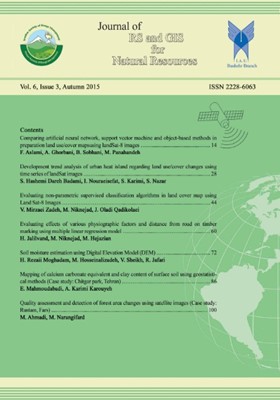Development trend analysis of urban heat island regarding land use/cover changes using time series of landSat images
Subject Areas : Geospatial systems developmentSirous Hashemi Dareh Badami 1 , Isar Nouraeisefat 2 , Saeid Karimi 3 , Sajad Nazari 4
1 - MSc. Student of Remote sensing and GIS, University of Tehran
2 - MSc. Student of Environmental Sciences, University of Tehran
3 - Assis. Prof. College of Environmental Sciences, University of Tehran
4 - MSc. Graduated of Geography and Urban Planning, Islamic Azad University, Kermanshah Branch
Keywords:
Abstract :
Using time series of satellite images is a cheap and efficient way to study trend changes of natural and human phenomena. The aim of the studyis to analyze the development of Urban Heat Iisland (UHI) in Rasht using time series satellite images. For this study, time series of LandSat images during 1990 and 2015 were used. Thresholding Normalized Difference Vegetation Index (NDVI) and Fraction Vegetation Cover (FVC) method has been applied to obtain the land surface emissivity; in addition, Planck's law for TM and ETM+ images and Split Window (SW) algorithm for OLI/TIRS images were utilized in order to retrieve land surface temperature. UHI and FVC trends were analyzed by statistical and Mann-Kendall methods. Statistical analysis showed that the average of FVC has decreased during the study periodand data skewness has changed to low FVC. The reduction trendhas increased FVC caused an average normalized temperature during the study period and also enhanced the data skewness of land surface temperature. The Mann-Kendall spatial analysis showed that in most of the study area, the land surface temperature and vegetation fraction haveincreased and decreasing trends, respectively; these mentioned trends have been intensified in the places where gardens and agricultural land uses were changed into built-up ones.


